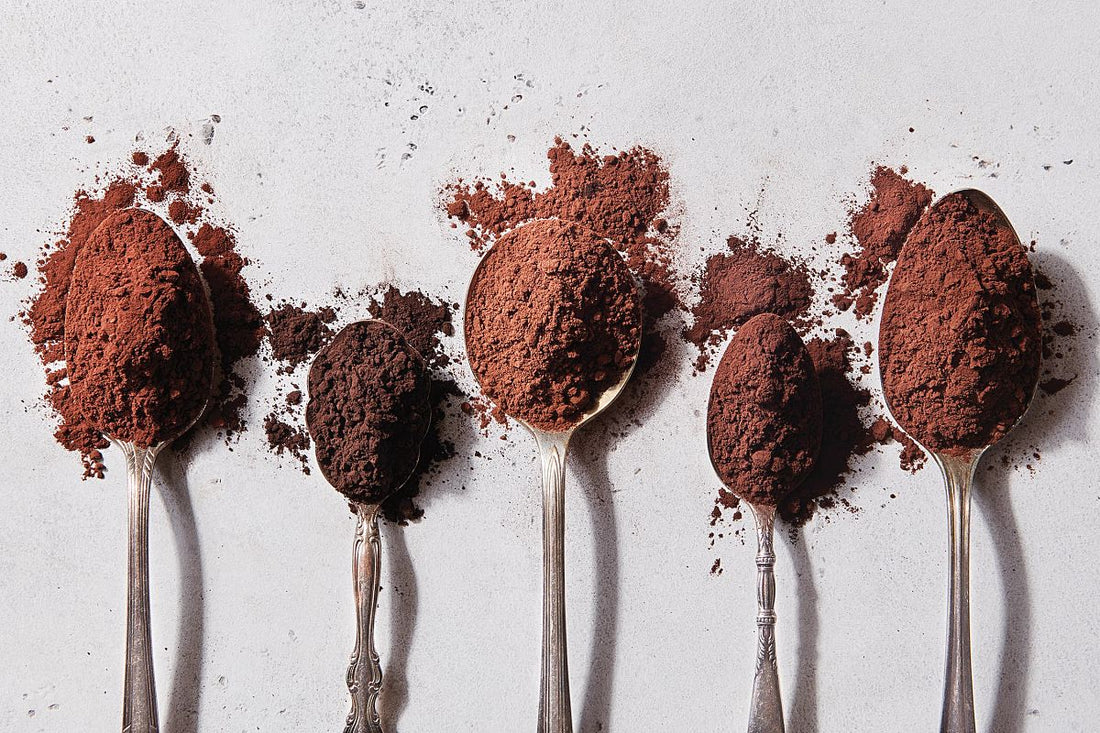We’ve all heard that dark chocolate is better for you than milk chocolate, but do you know the difference between cacao and cocoa? Suddenly what used to be called cocoa is now being called cacao. Most people don’t know if they are the same thing or something different while brand marketers are using the public’s ignorance to make people think something new and more exciting than cocoa is in their products.
Carob has been in use for thousands of years and was called “St. John’s bread” because it is believed to be the food referred to in the Bible that sustained St. John in the desert. Despite its many centuries of traditional food consumption in Mediterranean countries, it isn’t nearly as well studied as cacao for its effects on human health. Our love for chocolate has made cacao one of the most studied plants in the world.
Both carob and cacao / cocoa have numerous health benefits so let’s compare what is known and why you might use one rather than the other.
Cacao versus cocoa – what’s the difference?
“Cacao” is the second part of the Latin name given to the tree, Theobroma cacao, that produces the bean used to make chocolate. “Theobroma” is derived from the Latin for “food of the gods”, which reflects the reverence that the original Central American indigenous cultures, the Aztecs and the Maya, held for cacao.
The name ‘cacao’ itself originally comes from the language of the Olmecs, who were the first Central American culture to use cacao. When the Spaniards arrived to find the Aztec emperor drinking a brew made from cacao beans, they adopted the name ‘cacao’ from the native name, “kakaw”, as it was known to the Maya and Aztecs.

Enter cocoa, the drink Hershey’s made popular as hot chocolate. Cocoa is the fermented, roasted, and ground cacao bean that is naturally bitter. Commonly, people think of hot chocolate as cocoa but hot chocolate actually includes lots of sugar to sweeten the cocoa.
Recently, brands started marketing raw, i.e. unroasted, cacao powder and called it ‘cacao’ to distinguish it from roasted cocoa. However, that distinction has become blurred as brand marketers used ‘cacao’ to refer to both roasted and unroasted because ‘cacao’ it made it sound more mysterious and appealing than cocoa.
It’s always profitable to confuse the consumer into thinking they’re getting something new and different! Most people don’t know what cacao is, so ingredient labels using ‘cacao’ lead them to believe that whether it is roasted or not, it’s an exciting new super food and not just plain old ‘cocoa’. In reality, they are interchangeable names for the same ingredient.
Alkalized cacao / cocoa powder – good or bad?
The Dutch discovered that by adding an alkalizing agent, such as potassium carbonate, to roasted cocoa, the color is deepened, and the flavor is less acidic and thus less bitter. Sounds good, right? The problem though with alkalized cocoa is that the alkalization process reduces the natural polyphenols that are abundant in cacao and are responsible for its beneficial health effects.
Personally, I’ve come to prefer the full flavor of natural, roasted cacao over alkalized cocoa powder like you find in brands marketing hot chocolate. Yes, it doesn’t have as deep a color in a brew like Teeccino or when made into hot chocolate, but it has a fuller flavor profile with more health benefits. I’ll trade color for more polyphenols any day!
To solve the consumer confusion problem, it would be great if we, as marketers, could all agree to call alkalized cacao, “cocoa”, and reserve cacao for the un-alkalized ingredient. Then it would be proper to state whether the natural cacao is roasted or raw. That way consumers could clearly pick their preference!
Antioxidants in cacao and carob
Both cacao and carob contain a diverse group of polyphenols including flavanols and flavonoids which have antioxidant effects in the body that combat free radical damage to our DNA. Cacao is rich in flavanols, including epicatechin and catechin which have been widely researched because they are also in green tea, grapes and berries. The catechins have many health benefits including anti-inflammatory effects, cardio-protective benefits and the support of beneficial probiotics in the gut.
Carob flavanols also include epicatechin along with gallic acid and flavonoids, quercetin and myricetin. Gallic acid is also known to have anti-inflammatory and cardo-protective effects like the catechins. Although not well researched, all polyphenols in carob are antioxidants with health benefits like those in cacao.
Energy from cacao versus carob
Let’s start with defining energy. Marketers would have you believe that caffeine and lesser stimulants like theobromine, both of which are in cacao, give you energy in products like energy drinks. In fact, this isn’t true; they don’t help your cellular metabolism produce energy. What they do is delay fatigue.
Caffeine and theobromine do this by competing with adenosine, which is produced in the brain as a neurotransmitter that depresses the central nervous system. Adenosine gradually builds up during the day and promotes sleep at night. Stimulants like caffeine and theobromine keep adenosine from binding with the A1 receptors in our brain which keeps us from feeling natural fatigue. Adenosine also helps us feel calmer which may be why caffeine increases anxiety in many people.
Theobromine, however, doesn’t seem to have many of the negative side effects caused by caffeine such as jitters and nervous tension making cacao an easier stimulant for people who are sensitive to caffeine. Watch out though; theobromine has a much longer half-life than caffeine, so its stimulant effects affect your system longer even if it is milder. It can interfere with sleep at night just like caffeine.
While you sleep, adenosine metabolizes in the brain so that when you awaken in the morning, you feel refreshed. Stimulant addicts don’t awaken feeling refreshed and many claim they can’t function until they gulp down their first cup of coffee. Their brains haven’t had a chance to recover fully from blocking the adenosine the day before and now they need to block it again in order to wake up.
If you’ve read my previous articles on how caffeine stimulates the fight or flight response, you’ll know that stimulants also exhaust the adrenal glands after causing them to produce too much cortisol, the stress response hormone. By increasing levels of cortisol, negative health effects cascade throughout the body causing all kinds of symptoms including poor digestion, muscular tension, migraines and insomnia.
D-Pinitol, the natural energizer in carob
Carob, on the other hand, has a far different mechanism for producing energy. A compound called D-Pinitol is found in legumes like soy, garbanzo beans and lentils. Carob pods, the outer casing of the carob seeds, are also legumes and have high levels of D-pinitol.
Acting as a blood sugar regulator, D-pinitol helps our cells reduce resistance to insulin and increase the uptake of glucose. We are naturally more energized when our cells have enough glucose to function efficiently and create more energy metabolically.
Our skeletal muscles also are influenced by D-pinitol to increase their uptake of glucose which helps support energy metabolism during exercise. A carob smoothie before working out may be just the thing to optimize performance and endurance.
Nutritional difference between cacao and carob
Both cacao and carob are highly nutritious but important differences may make one or the other a better fit depending on your needs. Cacao is higher in protein, but carob is higher in fiber. Cacao is very high in fat while carob is low in fat. Both have an abundance of minerals while carob is higher in calcium and cacao is higher in iron, copper and magnesium.
Probably the most significant nutritional difference between carob and cacao is the natural sweetness of carob compared to the bitterness of cacao. Carob doesn’t need additional sweeteners because it naturally contains approximately 48-56% sugars composed of sucrose, glucose, and fructose. On the other hand, most people won’t consume cacao without an added sweetener. This makes a big difference in both beverages and foods where you need to counteract cacao’s bitterness with sweeteners. To avoid high calories from sweeteners, you can use a non-caloric sweetener like monk fruit or stevia. With carob, it can help sweeten a beverage or baked good allowing you to reduce the amount of added sugar.
Cacao and carob in Teeccino
We attribute some of the natural energy boost people experience when they drink Teeccino to carob, one of the primary ingredients in it. We believe the D-pinitol in carob helps people feel energized as it supports their cells and metabolizes their blood sugar. Roasted carob contains reduced sugars from the raw, but it still helps many people reduce the amount of sugar they would normally use in coffee which, like cacao, is much more bitter than carob.

We use roasted cacao to flavor our chocolate blends with rich chocolate notes. Although caffeine is in cacao, our chocolate blends are still able to be called caffeine free because the caffeine is a lower percentage of the stimulants in cacao and as a flavoring in Teeccino, there is only a trace amount of caffeine. There is, however, around 5mg of theobromine in a cup of a chocolate Teeccino blend so if you need to avoid all stimulants, we recommend drinking the many Teeccino blends that don’t contain cacao.
All our roasted cacao is natural, not alkalized. We want to offer the most healthful beverage possible, so we value the antioxidants in the natural cacao above all!



3 comments
Question: Are the tea bags bleached!!!
Thank you
Thanks for the thorough info!!
Excellent article! This clears up a lot of misinformation.
Thank you